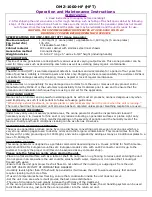
5. Troubleshooting
5-1 Troubleshooting Method and Precautions
5-1-1 Checking of power source
5-1-2 Check the parts that be weak or fragile
5-1-3 Check the terminals for proper connection
5-1-4 Refer to the table below when there is any malfunction;
Samsung Electronics
5-1
Check to see whether the voltage of the power source is 220 ~ 240V, 50Hz.
The air conditioner may not operate properly if the voltage is out of this range.
Procedures
1
Check to see whether the electric circuit or electric parts are damaged before repairing the air conditioner.
2
Conduct the following generally to check whether the electric circuit or other electric parts are damaged.
No
Trouble
Checkpoints
Possible cause
①
➁
➂
➃
➄
The compressor
does not operate.
The motor does
not operate.
The cooling capacity
is low.
The heating capacity
is low
Noise
1. Check the position of the thermostat.
2. Check the position of the select switch.
3. Check the connection of the lead wire.
4. check the overload protector.
5. Check the compressor.
1. Check the connection of the lead wire
and switch.
2. Check the motor.
3. Check whether the unit is deicing.
1. Check the refrigerant for leak.
2. Check the evaporator condition.
(freezing, clogging with dust, etc.)
❊
The temperature difference between
the air inlet side and air outlet side
should be 12°C at the minimum.
❊
Standard state
Indoor : 27°C, Outdoor : 35°C
1. Check the refrigerant for leak.
2. Check the evaporator condition.
(freezing, clogging with dust, etc.)
3. Check whether the drain equipment
(DRAIN PAN, DRAIN TUBE) is installed.
❊
The temperature difference between
the air inlet side and outlet side
should be 12°C at the minimum.
❊
Standard state
Indoor : 20°C, Outdoor : 7°C
❊
Adequate operating temperature
• Heating : Indoor : 0°C~21°C approx.
Outdoor : 28°C or less.
1. Check the vibration of the pipe.
2. Check the propeller fan and blower for
looseness and weakness.
3. Check the motor bearing for noise.
4. Compare the compressor noise with
other compressors.
1. The setting temperature is higher than the
room temperature in cool mode.
2. The setting temperature is lower than the
room temperature in heat mode.
3. Lead wire disconnected.
4. O.L.P. damaged.
5. Compressor damaged.
1. Lead wire disconnected.
2. Switch damaged.
3. Motor damaged.
4. The unit is operating on the deice mode.
1. The leak is caused by a pipe crack.
2. Shortage of the refrigerant.
3. Clean the evaporator, and air filter.
1. The leak is caused by a pipe crack.
2. Shortage of the refrigerant.
3. Clean the evaporator, and air filter.
4. Install the drain pan and drain plug.
1. The pipe is in contact with other parts.
2. The tightening of the hexagon nut is faulty.
3. Damage of the motor.
4. Damage of the compressor.





























